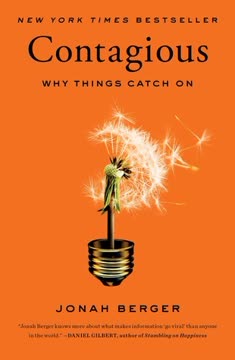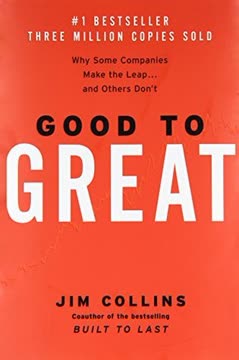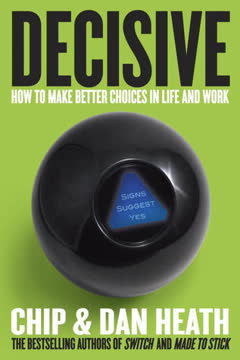Key Takeaways
1. Simple: Find the core and share it compactly
"If you argue ten points, even if each is a good point, when they get back to the jury room they won't remember any."
Find the core. The essence of making ideas stick is to strip them down to their most critical elements. This process involves relentlessly prioritizing and excluding superfluous information. Like the Army's "Commander's Intent," which provides a clear, concise objective for soldiers to follow in unpredictable situations, your message should have a singular focus that can guide action and decision-making.
Share the core compactly. Once you've identified the core idea, communicate it in a way that's both simple and profound. This doesn't mean dumbing down your message, but rather expressing it concisely and memorably. Consider proverbs as a model: they pack deep wisdom into short, easily remembered phrases. For example, Southwest Airlines' core idea of being "THE low-fare airline" guides employee behavior across countless situations, from deciding whether to serve chicken salad to choosing which routes to fly.
- Examples of compact, core ideas:
- "Names, names, and names" (Hoover Adams' newspaper strategy)
- "It's the economy, stupid" (Clinton's 1992 campaign focus)
- "Man on the moon before the decade is out" (Kennedy's space goal)
2. Unexpected: Break patterns to grab and hold attention
"Surprise acts as a kind of emergency override when we confront something unexpected."
Grab attention by violating expectations. Our brains are wired to notice changes and pay attention to the unexpected. To make your ideas stick, you need to break people's existing mental patterns. This could be as simple as a flight attendant delivering a humorous safety announcement or as profound as presenting a counterintuitive fact that challenges common beliefs.
Hold attention by creating and filling knowledge gaps. Once you've captured attention, maintain it by creating curiosity. Highlight gaps in people's knowledge and then fill them. This is why mystery novels are so engaging – they create a knowledge gap (who did it?) that keeps us reading until it's resolved. In your communication:
- Pose questions or puzzles that your audience will want answered
- Present incomplete information that creates a desire for closure
- Use the "news-teaser" approach: hint at interesting information to come
Examples:
- Nora Ephron's journalism teacher revealing the surprising lead: "There will be no school next Thursday"
- The "Truth" anti-smoking campaign shocking teens with the tobacco industry's deceptive practices
3. Concrete: Make ideas tangible and memorable
"Abstraction makes it harder to understand an idea and to remember it. It also makes it harder to coordinate our activities with others, who may interpret the abstraction in very different ways."
Use concrete language and examples. Abstract ideas are hard to grasp and remember. Make your ideas concrete by using sensory language, vivid imagery, and specific examples. This helps people understand, remember, and relate to your message. For instance, rather than talking about "improving customer service," share a story about a Nordstrom employee who gift-wrapped a present bought at Macy's.
Bring statistics to life. Numbers alone are often forgettable. Make them concrete and impactful by putting them into a human context. For example:
- Instead of "37 grams of saturated fat," say "as much saturated fat as a bacon-and-eggs breakfast, a Big Mac and fries for lunch, and a steak dinner with all the trimmings—combined!"
- Rather than "5,000 nuclear warheads," demonstrate the scale by dropping 5,000 BBs into a metal bucket
Use analogies and metaphors. These tools help people understand new concepts by relating them to familiar ones. For example, Disney refers to its employees as "cast members," instantly conveying expectations about performance and customer interaction.
4. Credible: Help people believe through authority and details
"A credible idea makes people believe. An emotional idea makes people care. The right stories make people act."
Tap into external credibility. Use authorities, experts, or anti-authorities to bolster your message. An anti-authority can be particularly effective when targeting skeptical audiences. For example, the anti-smoking campaign featuring Pam Laffin, a young mother dying from smoking-related illness, was more impactful than lectures from health experts.
Build internal credibility. Make your ideas more believable by:
- Using vivid details: Specific, concrete details make a story feel more real and credible.
- Employing statistics on a human scale: Make numbers relatable by comparing them to familiar concepts.
- Using the "Sinatra Test": Find one example so strong that it alone establishes credibility. ("If you can make it there, you'll make it anywhere.")
- Providing "testable credentials": Allow your audience to test your claims themselves.
Examples:
- The "Where's the beef?" campaign allowing customers to visually compare burger sizes
- A textile factory that purifies water, demonstrating environmental commitment
- The NBA rookie orientation where players unknowingly interact with HIV-positive women, making the risk tangible
5. Emotional: Make people care using self-interest and identity
"If I look at the mass, I will never act. If I look at the one, I will."
Appeal to self-interest. Show people how your idea benefits them personally. This doesn't always mean appealing to base desires; consider Maslow's hierarchy of needs, including higher-level needs like self-actualization. For example, Floyd Lee, running a mess hall in Iraq, motivated his staff by framing their job as "being in charge of morale," not just serving food.
Tap into identity. People make decisions based on their sense of identity. Frame your message to align with how people see themselves or how they want to be seen. The "Don't Mess with Texas" anti-littering campaign succeeded by appealing to Texans' pride and identity, rather than using traditional environmental messages.
Use the power of one. People are more likely to care about individuals than large groups or abstract concepts. This is why charities often focus on a single child's story rather than statistics about widespread poverty.
- Strategies to make people care:
- Show how your idea affects a single, relatable individual
- Appeal to group identity (e.g., "What would someone like me do in this situation?")
- Connect your message to higher-level aspirations and values
6. Stories: Inspire action through simulation and inspiration
"Stories are like flight simulators for the brain."
Use stories to simulate. Stories act as mental flight simulators, allowing people to imagine themselves in situations and rehearse responses. This makes them powerful tools for teaching and inspiring action. For example, sharing stories of how employees solved problems can help others navigate similar situations in the future.
Inspire through stories. Certain story plots are particularly effective at motivating action:
- Challenge Plot: Overcoming obstacles (e.g., David vs. Goliath)
- Connection Plot: Bridging gaps between people (e.g., the Good Samaritan)
- Creativity Plot: Solving problems in innovative ways (e.g., the Apple falling on Newton's head)
Spot and share sticky stories. You don't always need to create stories from scratch. Be on the lookout for real-life stories that embody your message, like the Subway employee who dramatically lost weight eating their sandwiches, which became the Jared campaign.
- Elements of effective stories:
- Concrete details that make the story feel real
- Unexpected twists that maintain interest
- Emotional resonance that makes people care
- A clear connection to your core message
7. Overcome the Curse of Knowledge to communicate effectively
"The Curse of Knowledge is a villain in our stories about why some ideas fail to stick."
Recognize the Curse of Knowledge. As experts, we often forget what it's like not to know something. This "curse" makes it difficult to communicate effectively with those who don't share our knowledge base. It's like being a "tapper" in the tapping game, frustrated that "listeners" can't guess the song you're tapping out.
Strategies to combat the Curse:
- Use concrete examples and analogies to bridge the knowledge gap
- Tell stories that illustrate your points in relatable ways
- Test your message with people outside your field of expertise
- Consistently refer back to the SUCCESs checklist to ensure your ideas are accessible
Remember, what seems obvious to you may be novel to your audience. Always strive to translate your expertise into terms and concepts that are easily understood by your target audience.
8. Use the SUCCESs checklist to make ideas stick
"There is no 'formula' for a sticky idea—we don't want to overstate the case. But sticky ideas do draw from a common set of traits, which make them more likely to succeed."
Apply the SUCCESs framework. Use this checklist to evaluate and improve the "stickiness" of your ideas:
- Simple: Find the core and express it concisely
- Unexpected: Grab attention by breaking patterns
- Concrete: Make ideas tangible and memorable
- Credible: Help people believe
- Emotional: Make people care
- Stories: Inspire action
Combine elements for maximum impact. The most sticky ideas often incorporate multiple elements of the SUCCESs framework. For example, the "Don't Mess with Texas" campaign was Simple (clear message), Unexpected (coming from a state known for independence), Concrete (specific action), Credible (featuring local celebrities), Emotional (appealing to state pride), and used Stories (showing real Texans taking action).
Iterate and refine. Creating sticky ideas is a skill that can be developed. Use the SUCCESs framework as a tool for continuous improvement:
- Analyze successful sticky ideas to understand how they work
- Apply the framework to your own ideas and messages
- Test your ideas with your target audience
- Refine based on feedback and results
Remember, you don't need to be a creative genius to create sticky ideas. By systematically applying these principles, anyone can dramatically improve the impact and memorability of their communication.
Last updated:
FAQ
What's Made to Stick about?
- Core Concept of Stickiness: Made to Stick by Chip Heath explores why some ideas are memorable and impactful while others fade away. It introduces the SUCCESs framework, which stands for Simple, Unexpected, Concrete, Credible, Emotional, and Stories.
- Real-World Applications: The authors provide numerous examples from various fields, including marketing, education, and public health, to illustrate how to make ideas stick.
- Focus on Communication: The book emphasizes the importance of effective communication in ensuring that ideas resonate with audiences and lead to action.
Why should I read Made to Stick?
- Improved Communication Skills: Reading Made to Stick can enhance your ability to convey ideas clearly and persuasively, which is valuable in both personal and professional contexts.
- Practical Framework: The six principles outlined in the book serve as a practical framework for crafting messages that resonate with audiences, making it easier to achieve desired outcomes.
- Engaging Examples: The Heath brothers use engaging stories and case studies, making the book not only informative but also enjoyable to read.
What are the key takeaways of Made to Stick?
- Six Principles of Stickiness: The book emphasizes the importance of simplicity, unexpectedness, concreteness, credibility, emotions, and stories in making ideas memorable.
- Curse of Knowledge: It discusses the "Curse of Knowledge," which refers to the difficulty experts have in communicating effectively with novices due to their own advanced understanding.
- Importance of Context: The authors highlight how context and relatable examples can significantly enhance the stickiness of an idea.
What is the SUCCESs framework in Made to Stick?
- Acronym Breakdown: The SUCCESs framework stands for Simplicity, Unexpectedness, Concreteness, Credibility, Emotions, and Stories. Each principle contributes to making ideas more memorable.
- Application of Principles: The authors provide strategies for applying each principle, such as finding the core of your message (Simplicity) or using vivid imagery (Concreteness).
- Checklist for Communication: This framework serves as a checklist for anyone looking to improve their communication skills, ensuring that their ideas are impactful.
How does the Curse of Knowledge affect communication?
- Understanding Gaps: The Curse of Knowledge makes it difficult for experts to remember what it was like to be a novice, leading to communication that may be too complex or abstract.
- Need for Simplification: Experts often struggle to simplify their ideas, which can result in misunderstandings or disengagement from their audience.
- Strategies to Overcome: The book suggests using concrete examples and relatable analogies to bridge the gap between expert knowledge and novice understanding.
What role do emotions play in making ideas stick according to Made to Stick?
- Emotional Connection: The book emphasizes that ideas that evoke strong emotions are more likely to be remembered and acted upon.
- Types of Emotions: Different emotions can be harnessed, such as fear, joy, or disgust, depending on the message you want to convey.
- Storytelling and Emotion: Stories that elicit emotional responses can create a lasting impact, making the message more relatable and engaging.
What is the significance of storytelling in Made to Stick?
- Power of Narrative: Stories are a powerful tool for communication because they help to illustrate complex ideas in a relatable way.
- Engagement and Retention: People are more likely to remember information presented in story form, as it creates a mental framework for understanding.
- Cultural Universality: The authors argue that storytelling is a universal method of communication that transcends cultures and time, making it an effective strategy for sharing ideas.
Can you give examples of sticky stories from Made to Stick?
- Kidney Heist Urban Legend: This story is a memorable urban legend that illustrates how unexpected and vivid details can make an idea stick.
- CSPI Popcorn Campaign: The campaign against unhealthy movie popcorn used shocking comparisons to make the health risks concrete and relatable, leading to significant changes in consumer behavior.
- Don’t Mess with Texas: This campaign successfully reduced littering by appealing to Texans' pride and identity rather than using guilt or fear tactics.
How can I apply the principles from Made to Stick in my work?
- Identify Your Core Message: Start by distilling your idea down to its most essential point, ensuring clarity and focus.
- Use Concrete Examples: Incorporate vivid, relatable examples that your audience can visualize and connect with emotionally.
- Engage with Stories: Craft your message into a narrative that captures attention and illustrates your point, making it more memorable.
What are some effective strategies for making ideas stick according to Made to Stick?
- Use Stories: Incorporate narratives that illustrate your message, as stories are more memorable and relatable than abstract concepts.
- Create Curiosity: Use unexpected elements to pique interest and encourage your audience to seek more information.
- Focus on the Individual: Highlight personal stories or examples that resonate emotionally with your audience.
What are some memorable quotes from Made to Stick and their meanings?
- “No plan survives contact with the enemy.”: This quote highlights the importance of adaptability and simplicity in communication, suggesting that clear core messages are essential in unpredictable situations.
- “If you say three things, you don’t say anything.”: This emphasizes the need for focus in communication; too many points can dilute the message and confuse the audience.
- “If I look at the mass, I will never act. If I look at the one, I will.”: This quote emphasizes the power of individual stories in inspiring action.
How does Made to Stick address the importance of context in communication?
- Contextual Relevance: The book highlights how context and relatable examples can significantly enhance the stickiness of an idea.
- Relatable Scenarios: Using scenarios that the audience can relate to helps in making the message more understandable and memorable.
- Cultural and Situational Awareness: Understanding the cultural and situational context of your audience can help tailor your message for maximum impact.
Review Summary
Made to Stick is widely praised for its practical approach to creating memorable ideas. Readers appreciate its concrete examples, simple principles (SUCCESs), and engaging writing style. Many find it useful for improving communication in various fields. The book is lauded for practicing what it preaches, making its own content "sticky." Some criticize it for being repetitive or dated, but most reviewers consider it a valuable resource for anyone looking to make their ideas more impactful and memorable.
Similar Books










Download PDF
Download EPUB
.epub digital book format is ideal for reading ebooks on phones, tablets, and e-readers.









